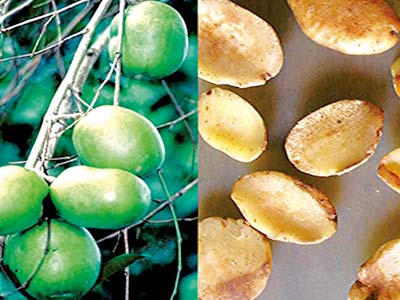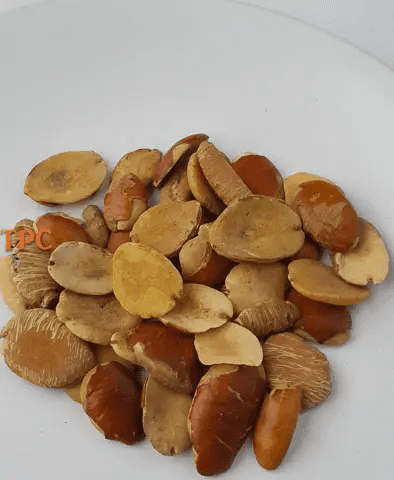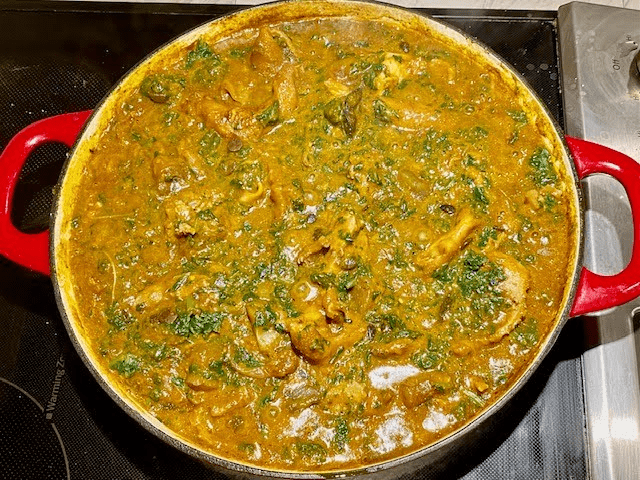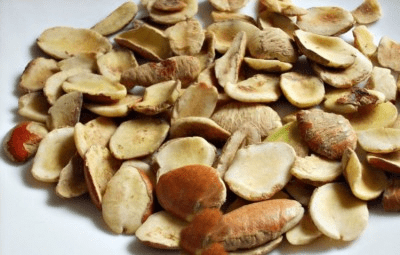In Nigeria, some trees in this category include Ogbono (irvingea spp), Akee-apple (Isin), Chrysophyllum albidum (white star-apple), Gmelina arborea, Dacryodes edulis (African pear), Butyrospermum parkii (shea butter tree), and Tetrapleura tetraptera (Aidan tree). This guide will briefly explain the cultivation of Ogbono (Irvingia spp.).
There are many tree species in the tropics that could be useful, but they are still unknown to the international market and scientists, so they are not being used.
Read Also: Ogbono (African Bush Mango): Facts, Health Benefits and Uses
Seed Extraction

Select ripe fruits, preferably those that have fallen naturally. Avoid using fruits that have been plucked. Remove the pulp completely and wash the nuts thoroughly using sand and water.
Let the nuts dry in the shade for one to two days in the dry season or three to four days in the wet season. If drying lasts more than seven days, the seed viability will decrease. Drying should be done in an open, airy space, not directly in the sun.
Seed Germination

Germinate seeds in a thick, strong polythene bag, basket, or perforated tray. Fill the container with rich topsoil up to 17 cm, then add uncontaminated sawdust to the next 10 cm. Plant the seed in the center of the bag, making sure it is well covered by the sawdust. Plant the seeds within two or three days after extraction.
If you have issues with damping-off disease, treat the seeds with benlate or another suitable fungicide. After planting, water daily and keep the container in a shaded area. For a 15 cm diameter bag, plant 3–4 seeds.
Germination should start about three weeks after planting and continue for several weeks. About 12 months after germination, the seedlings are ready to be transplanted to the field or budded.
Budding
For budding, obtain bud wood from mature flowering trees, preferably in June during the rainy season. Use rootstock about 0.5 cm in diameter (about pencil size) and 15cm from the soil surface.
Budding should be done while the seedlings are still in the polythene bag in the nursery. Transplant the budded seedlings to the field 9–12 months after budding.
Field Establishment
Seedlings are ready to be transplanted to a permanent field site 9–12 months after germination or budding. Transplant the seedlings into pre-dug holes of 1m x 1m x 1m, at least two weeks before transplanting.
Fill the holes with topsoil, manure, and 15:15:15 compound fertilizer, thoroughly mixed. Field spacing should be 7m x 7m. Transplanting should be done in June during the rainy season, with the soil ball around the roots intact.
Field Management/Maintenance
Establish a cover crop to protect the soil, which should be phased out as the trees form their canopies. You may inter-crop with other crops like cassava for the first few years. Water or irrigate the seedlings during the first dry season after transplanting, as they may not have developed a deep root system.
Remove the first flowers that appear on the seedlings to allow strong vegetative growth, supported by manure, nitrogenous, and potassium fertilizers. Weed the seedlings regularly to ensure maximum yield from your inter-crop and later from the trees.
Harvesting
Harvest Irvingia when the fruits are mature. The timing of harvest depends on the intended use of the fruits. For shipping to markets, harvest when mature and green.
For fresh market use, allow the fruits to fully ripen and fall from the tree, then collect them once or twice daily. For germination purposes, use fully ripe fruits that have fallen naturally. Avoid harvesting damaged or bruised fruits to prevent disease.
Read Also: Harvesting Methods for Tropical and Cereal Crops
Uses

Irvingia fruits are considered delicacies because they are not commonly available. They are eaten fresh in southwestern and eastern Nigeria and are particularly valued as fruits and desserts in Ibadan.
The fresh fruits are becoming popular in northern Nigeria, thanks to southerners living there. The most popular use of Irvingia in Nigeria is as an ingredient in Ogbono soup, which is eaten with dishes like pounded yam, eba, amala, and semovita. Irvingia also has potential as a future juice drink.
Chemical Composition
Irvingia is a promising fruit tree for the future. Although little research has been done on its nutritional content, it is believed to have a chemical composition similar to that of mango.
The fruit is rich in vitamin C and proteins, and the seed is rich in protein, carbohydrates, and traces of vitamins. Irvingia is also said to have medicinal value.
Pests and Diseases
Irvingia trees generally have few pests and diseases. However, in some areas, fungal diseases like damping-off may occur, which can be controlled by dusting seeds with benlate or another suitable fungicide before planting.
In summary, at the end of this guide, you will have learned that Irvingia (Ogbono) is one of Nigeria’s potentially useful tree species that remains largely unknown to the international market and underutilized.
The fruit is widely used in Nigeria as fresh fruit, dessert, or as an essential ingredient in Ogbono soup, which is eaten with various traditional dishes. Irvingia is a tree crop with tremendous potential.
Read Also: Improve Your Soil: Composting Facts to Create Nutrient-Dense Soil

